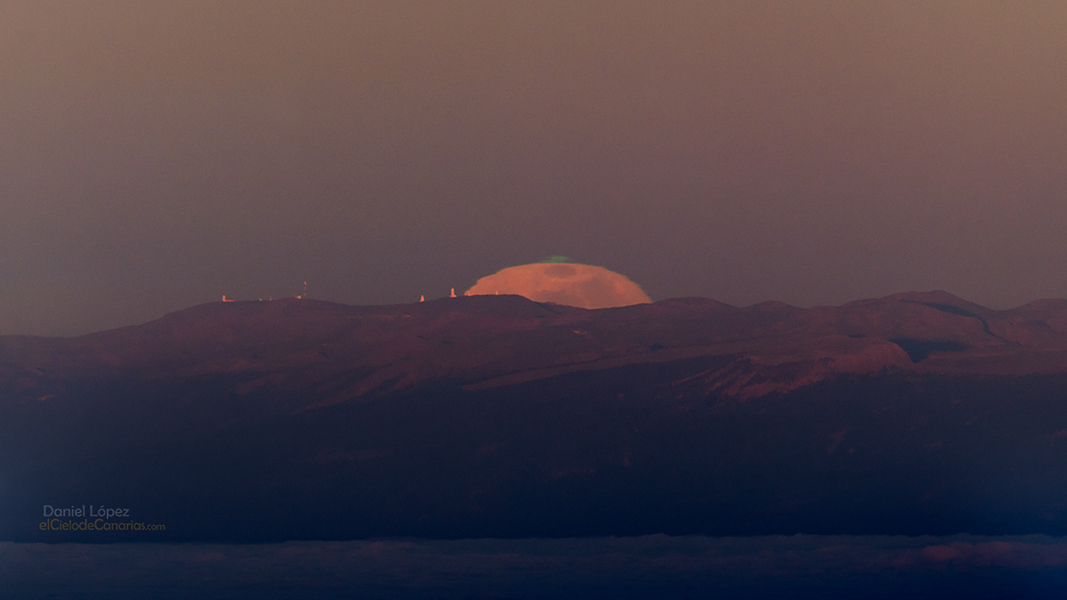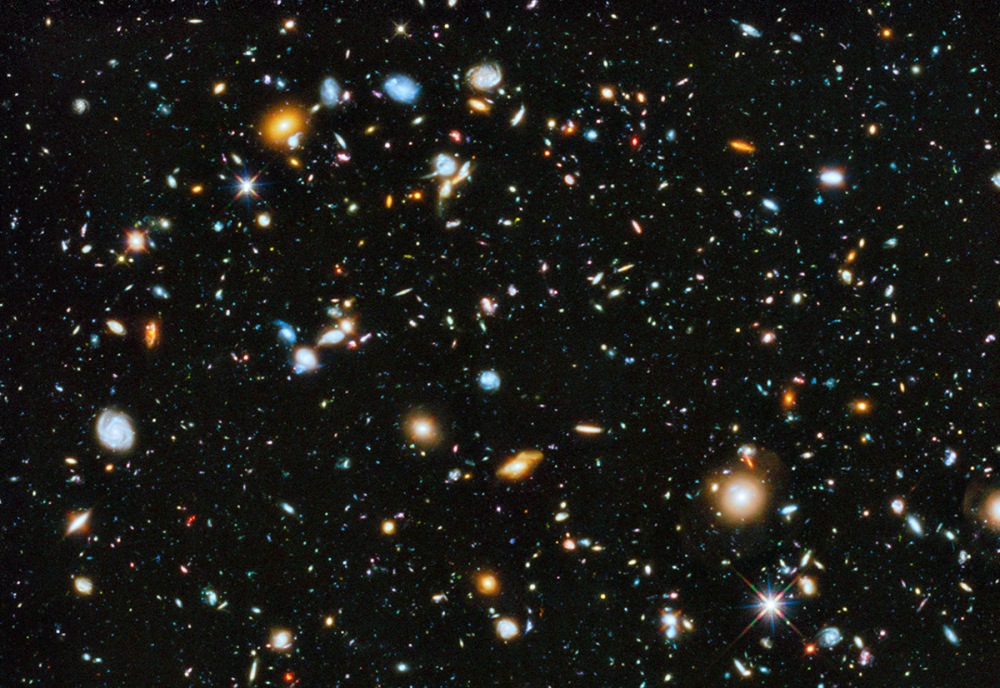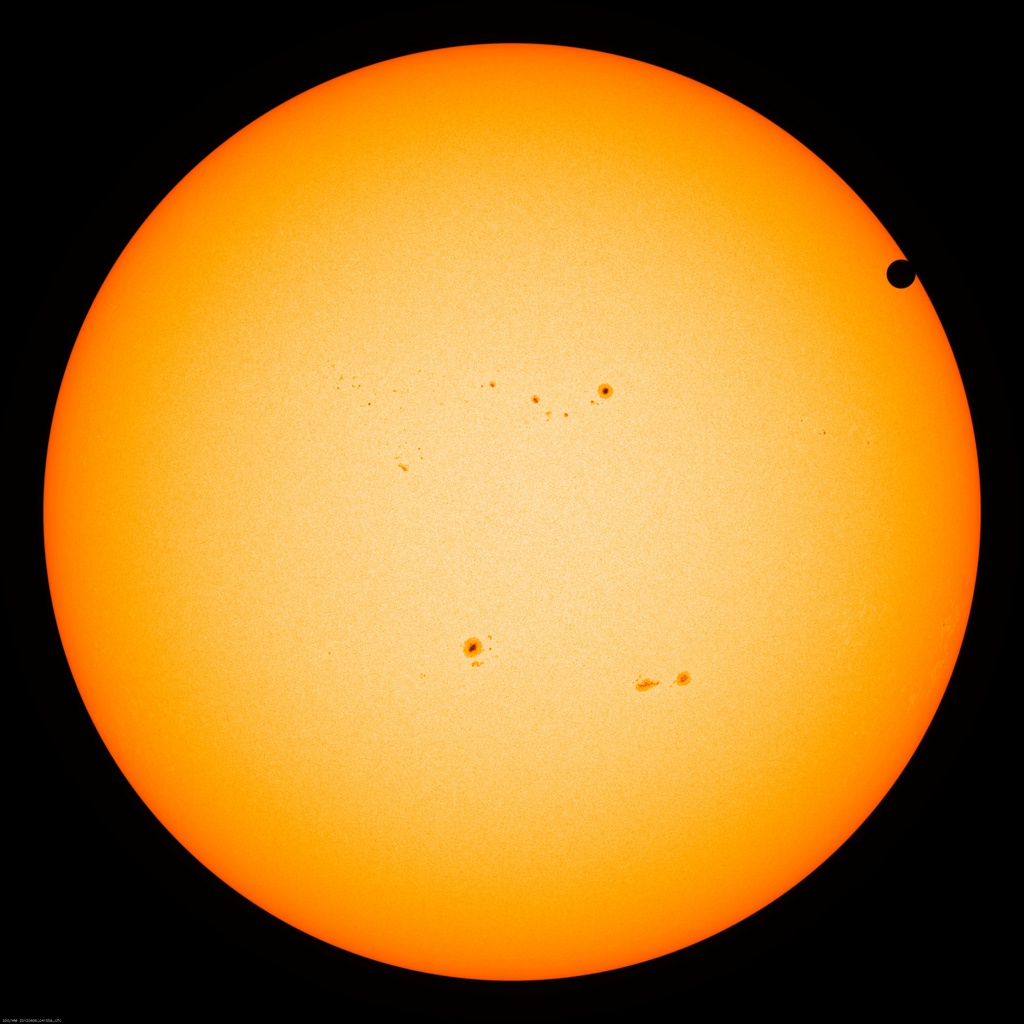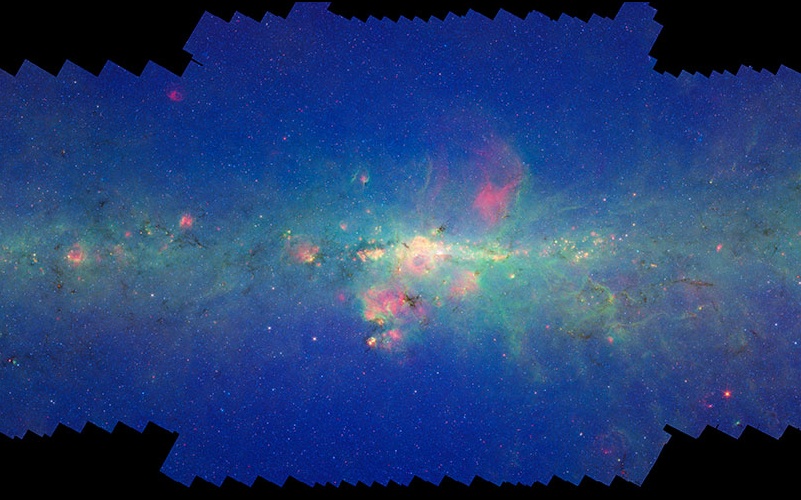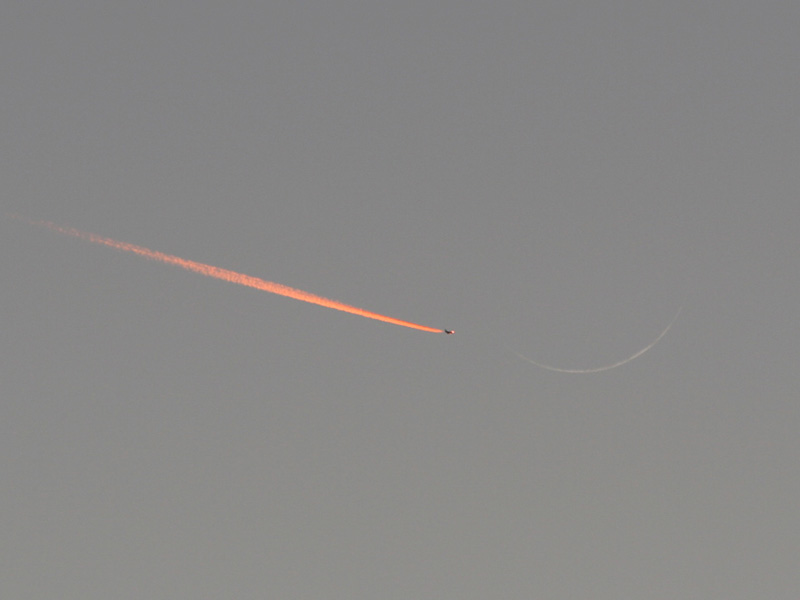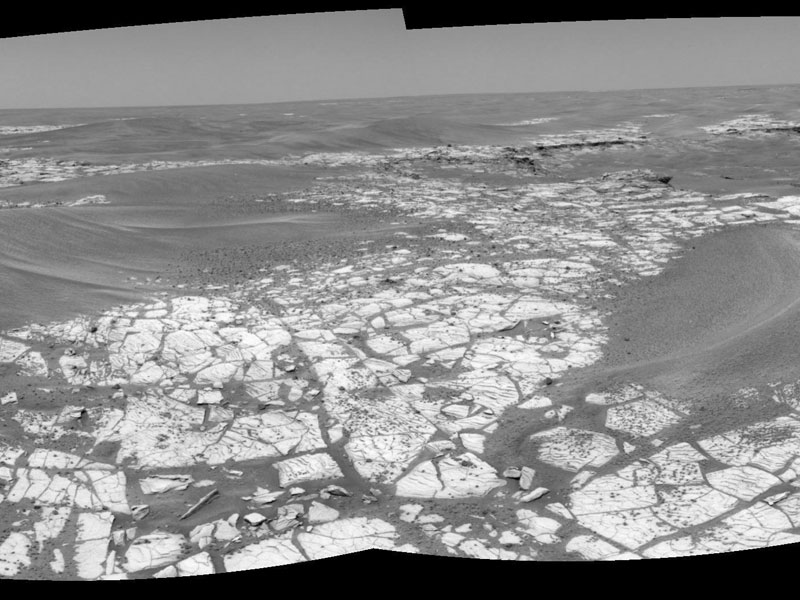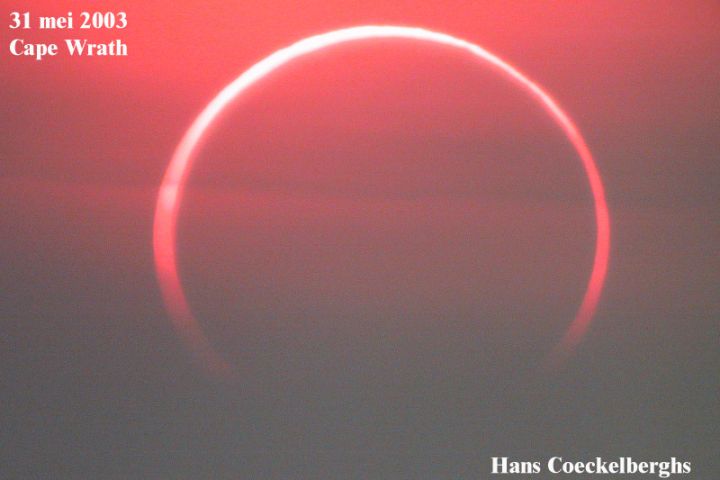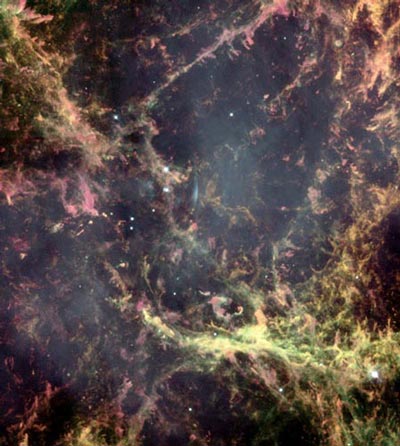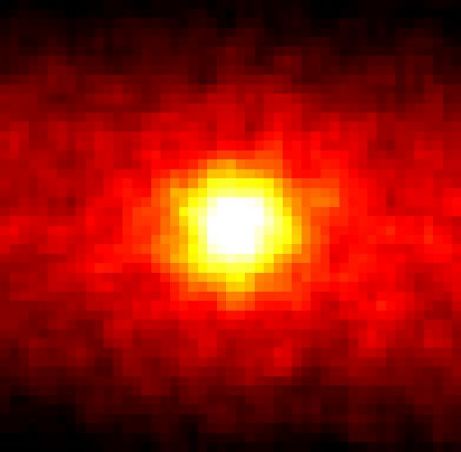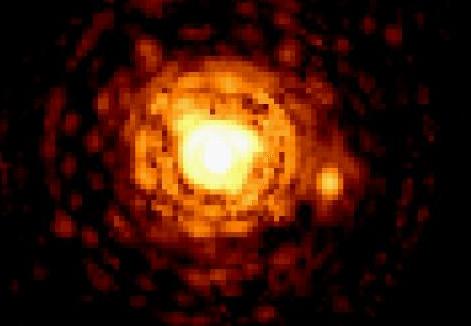| << Previous | Index | Next >> |
2015 Follow a sunset on a clear day against a distant horizon and you might glimpse a green flash just as the Sun disappears, the sunlight briefly refracted over a long sight-line through atmospheric layers. You can spot a green flash at sunrise too. Pinpointing the exact place and time to see the rising Sun peeking above the horizon is a little more difficult though, and it can be harder still to catch a green flash from the fainter rising Moon. But well-planned snapshots did record a green flash at the Full Moon's upper edge on June 2nd, from the Roque de los Muchachos Observatory on the Canary Island of La Palma. Looking a little south of due east, this long telephoto view finds the rising Moon above mountains and a sea of clouds. In sunlit profile are the mountaintop Teide Observatory telescope domes on the island of Tenerife some 143 kilometers away.
2014
2013 Except for the rings of Saturn, the Ring Nebula (M57) is probably the most famous celestial band. Its classic appearance is understood to be due to our own perspective, though. The recent mapping of the expanding nebula's 3-D structure, based in part on this clear Hubble image, indicates that the nebula is a relatively dense, donut-like ring wrapped around the middle of a football-shaped cloud of glowing gas. The view from planet Earth looks down the long axis of the football, face-on to the ring. Of course, in this well-studied example of a planetary nebula, the glowing material does not come from planets. Instead, the gaseous shroud represents outer layers expelled from the dying, once sun-like star, now a tiny pinprick of light seen at the nebula's center. Intense ultraviolet light from the hot central star ionizes atoms in the gas. In the picture, the blue color in the center is ionized helium, the cyan color of the inner ring is the glow of hydrogen and oxygen, and the reddish color of the outer ring is from nitrogen and sulfur. The Ring Nebula is about one light-year across and 2,000 light-years away.
2012 Today Venus moves in front of the Sun. One way to follow this rare event is to actively reload the above live image of the Sun during the right time interval and look for an unusual circular dark dot. The smaller sprawling dark areas are sunspots. The circular dot is the planet Venus. The dark dot will only appear during a few very specific hours, from about 22:10 on 2012 June 5 through 4:50 2012 June 6, Universal Time. This transit is the rarest type of solar eclipse known -- much more rare than an eclipse of the Sun by the Moon or even by the planet Mercury. In fact, the next transit of Venus across the Sun will be in 2117. Anyone with a clear view of the Sun can go outside and carefully view the transit for themselves by projecting sunlight through a hole in a card onto a wall. Because this Venus transit is so unusual and visible from so much of the Earth, it is expected to be one of the more photographed celestial events in history. The above live image on the Sun is being taken by the Earth-orbiting Solar Dynamics Observatory and can be updated about every 15 minutes.
2011 One of the brightest supernovas in recent years has just been recorded in the nearby Whirlpool galaxy (M51). Surprisingly, a seemingly similar supernova was recorded in M51 during 2005, following yet another one that occurred in 1994. Three supernovas in 17 years is a lot for single galaxy, and reasons for the supernova surge in M51 are being debated. Pictured above are two images of M51 taken with a small telescope: one taken on May 30 that does not show the supernova, and one taken on June 2 which does. The June 2 image is one of the first images reported to contain the supernova. The images are blinked to show the location of the exploded star. Although most supernovas follow classic brightness patterns, the precise brightening and dimming pattern of this or any supernova is hard to predict in advance and can tell astronomers much about what is happening. Currently, the M51 supernova, designated SN 2011dh, is still bright enough to follow with a small telescope. Therefore, sky enthusiasts are encouraged to image the Whirlpool galaxy as often as possible to fill in time gaps left by intermittent observations made by the world's most powerful telescopes. Views of the developing supernova are being uploaded here.
2010
2009 Cosmic dust clouds sprawl across a rich field of stars in this sweeping telescopic vista near the northern boundary of Corona Australis, the Southern Crown. Probably less than 500 light-years away and effectively blocking light from more distant, background stars in the Milky Way, the densest part of the dust cloud is about 8 light-years long. At its tip (upper right) is a group of lovely reflection nebulae cataloged as NGC 6726, 6727, 6729, and IC 4812. A characteristic blue color is produced as light from hot stars is reflected by the cosmic dust. The smaller yellowish nebula (NGC 6729) surrounds young variable star R Coronae Australis. Magnificent globular star cluster NGC 6723 is at the upper right corner of the view. While NGC 6723 appears to be part of the group, it actually lies nearly 30,000 light-years away, far beyond the Corona Australis dust clouds.
2008 The Spitzer Space Telescope's encompasing infrared view of the plane of our Milky Way Galaxy is hard to appreciate in just one picture. In fact, more than 800,000 frames of data from Spitzer's cameras have now been pieced together in an enormous mosaic of the galactic plane - the most detailed infrared picture of our galaxy ever made. The small portion seen here spans nearly 8 degrees, roughly the apparent width of your fist held at arms length, across the galaxy's center. The full mosaic is 120 degrees wide. Highlighted in the false-color presentation are curving green filaments of light from complex molecules - polycyclic aromatic hydrocarbons (PAHs) - that on Earth are the common, sooty products of incomplete combustion. The PAHs are found in star forming regions, along with reddish emission from graphite dust particles. Blue specks throughout the picture are individual Milky Way stars.
2007 No natural clouds appear in this picture. On the left, an airplane cruises through the atmosphere leaving a contrail in its wake. The contrail would normally appear white, but the large volume of air toward the setting Sun preferentially knocks away blue light, giving the reflected trail a bright orange hue. Far in the distance, to the right of the plane, is the young Moon. This vast world shows only a sliver of itself because the Sun is nearly lined up behind it. The above image is framed by an eerie gray sky, too far from day to be blue, too far from night to be black. Within minutes the impromptu sky show ended. The plane crossed the Moon. The contrail dispersed. The Sun set. The Moon set. The sky faded to black, only to reveal thousands of stars that had been hiding below the gray din.
2006 Here is a road never traveled. To get to Victoria Crater on Mars, the rolling robotic rover Opportunity must traverse the landscape shown above. Victoria Crater lies about one kilometer ahead. The intervening terrain shows a series of light rock outcrops that appears like some sort of cobblestone road. Surrounding this naturally-occurring Martian road, is Martian sand ripples that must be navigated around. Inspection of the outcrop road shows it to be sprinkled with many small round rocks dubbed blueberries. Opportunity and its sister robot Spirit continue their third year exploring Mars. Within the next month, planetary scientists hope to maneuver Opportunity across Meridiani Planum to get a good view of 800-meter diameter Victoria Crater.
2005 Most bright stars in our Milky Way Galaxy reside in a disk. Since our Sun also resides in this disk, these stars appear to us as a diffuse band that circles the sky. The above panorama of a northern band of the Milky Way's disk covers 90 degrees and is a digitally created mosaic of several independent exposures. Scrolling right will display the rest of this spectacular picture. Visible are many bright stars, dark dust lanes, red emission nebulae, blue reflection nebulae, and clusters of stars. In addition to all this matter that we can see, astronomers suspect there exists even more dark matter that we cannot see.
2004 In December of 1972, Apollo 17 astronauts Eugene Cernan and Harrison Schmitt spent about 75 hours exploring the Moon's Taurus-Littrow valley while colleague Ronald Evans orbited overhead. Cernan and Schmitt were the last humans to walk or ride on the Moon - aided in their explorations by a Lunar Roving Vehicle. The skeletal-looking lunar rover was just over 10 feet long, 6 feet wide and easily carried astronauts, equipment, and rock samples in the Moon's low gravity (about 1/6 Earth's). In this picture, Cernan stands at the back of the rover which carried the two astronauts in lawn-chair style seats. An umbrella-shaped high gain antenna and TV camera are mounted in the front. Powered by four 1/4 horsepower electric motors, one for each wheel, this rover was driven a total of about 18 miles across the lunar surface. Its estimated top speed was a blazing 8 miles per hour.
2003 If the Moon's apparent diameter is not quite large enough to cover the Sun during a solar eclipse, an annular eclipse can be the result -- a spectacle of silhouetted Moon surrounded by a solar "ring of fire". Just such a view was possible for observers in the far northern hemisphere as the new Moon slid across the solar disk on May 31st. Still, for astronomical adventurers at Cape Wrath on the northwestern coast of Scotland, the eastern sky was cloudy on eclipse day. But fortunately the Sun became visible a few minutes prior to the annular phase and determined astronomer Hans Coeckelberghs was able to capture this dramatic telescopic image of the eclipsed Sun's ring of fire looming through a reddened, cloud-streaked sky. Not to be outdone by the north, the far southern hemisphere will host the next solar eclipse, with the path of totality racing across Antarctica on November 23rd.
2002 Far beyond the local group of galaxies lies NGC 3621, some 22 million light-years away. Found in the serpentine southern constellation Hydra, the loose spiral arms of this gorgeous island universe are loaded with luminous young star clusters and dark dust lanes. Still, for earthbound astronomers NGC 3621 is not just another pretty face-on spiral galaxy. Some of its brighter stars have been used as standard candles to establish important estimates of extragalactic distances and the scale of the Universe. This color picture was constructed from astronomical image data recorded with the Very Large Telescope Antu, at Paranal Observatory in Chile. At the original resolution, individual, hot supergiant stars can be identified and studied across NGC 3621.
2001 Orbiting the Sun between Mars and Earth, asteroid 433 Eros was visited by the robot spacecraft NEAR-Shoemaker in 2000 February. High-resolution surface measurements made by NEAR's Laser Rangefinder (NLR) have been combined into the above visualization based on the derived 3D model of the tumbling space rock. NEAR allowed scientists to discover that Eros is a single solid body, that its composition is nearly uniform, and that it formed during the early years of our Solar System. Mysteries remain, however, including why some rocks on the surface have disintegrated. On 2001 February 12, the NEAR mission drew to a dramatic close as it was crash landed onto the asteroid's surface, surviving well enough to return an analysis of the composition of the surface regolith. Unless re-awakened by NASA, NEAR will likely remain on the asteroid for billions of years as a monument to human ingenuity at the turn of the third millennium.
2000 The supernova explosion that formed the Crab Nebula was first seen on the year 1054. Last week, astronomers released a new image of the still-evolving center of the explosion. The above representative-color photograph was taken in colors emitted by specific elements including hydrogen (orange), nitrogen (red), sulfur (pink), and oxygen (green), with the result appearing oddly similar to a Jackson Pollock painting. Visible is a complex array of gas filaments rushing out at over 5 million kilometers per hour. Even at these tremendous speeds, though, it takes a filament over 600 years to cross the 3 light year wide frame. The rapidly spinning neutron star remnant of this ancient cataclysm is visible as the lower of the two bright stars just above the photograph center. The Crab Nebula (M1) is located 6,500 light-years away towards the constellation of Taurus.
1999 Betelgeuse (sounds a lot like "beetle juice"), a red supergiant star about 600 light years distant, is seen in this Hubble Space Telescope image - the first direct picture of the surface of a star other than the Sun. While Betelgeuse is cooler than the Sun, it is more massive and over 1000 times larger. If placed at the center of our Solar System, it would extend past the orbit of Jupiter. Betelgeuse is also known as Alpha Orionis, one of the brightest stars in the familiar constellation of Orion, the Hunter. The name Betelgeuse is Arabic in origin. As a massive red supergiant, it is nearing the end of its life and will soon become a supernova. In this historic image, a bright hotspot is revealed on the star's surface.
1998 Neutrinos, along with things like electrons and quarks, are fundamental pieces of matter according to physicists' Standard Model. But neutrinos are hard to detect. Readily produced in nuclear reactions and particle collisions, they can easily pass completely through planet Earth without once interacting with any other particle. Constructed in an unused mine in Japan, an ambitious large-scale experiment designed to detect and study neutrinos is known as Super-Kamiokande or "Super-K". Only(!) 500 days worth of data was needed to produce this "neutrino image" of the Sun, using Super-K to detect the neutrinos from nuclear fusion in the solar interior. Centered on the Sun's postion, the picture covers a significant fraction of the sky (90x90 degrees in R.A. and Dec.). Brighter colors represent a larger flux of neutrinos.
1997 A dim double star system cataloged as Gliese 623 lies 25 light-years from Earth, in the constellation of Hercules. The individual stars of this binary system were distinguished for the first time when the Hubble Space Telescope's Faint Object Camera recorded this image in June 1994. They are separated by 200 million miles - about twice the Earth/Sun distance. On the right, the fainter Gliese 623b is 60,000 times less luminous than the Sun and approximately 10 times less massive. The fuzzy rings around its brighter companion, Gliese 623a, are image artifacts. The lowest mass stars are classified as red dwarf stars, but even red dwarfs are massive enough to trigger hydrogen fusion in their cores to sustain their feeble starlight. Slightly less massive objects, known as brown dwarfs, can shine only briefly as their central temperatures are too low to utilize hydrogen as nuclear fuel. The present estimates of the mass of Gliese 623b are right at this red dwarf/brown dwarf border but future observations should help clarify the nature of one of our Galaxy's small stars. Dim and difficult to detect, an abundance of objects like Gl623b has been proposed as a possible solution to the mystery of "Dark Matter" in the Universe.
1996 What does the center of our Milky Way Galaxy look like? No one knows! It is not possible to see the Galactic center in light our eyes are sensitive to because the thick dust in the plane of our Galaxy obscures it. If one looks in the direction of our Galaxy's center - which is toward the constellation of Sagittarius - many beautiful wonders become apparent, though. The center of the Milky Way is behind the center of the photo. Large dust lanes and star clouds dominate the picture. As many as 30 Messier Objects are visible, including all types of nebula and star clusters. Two notable nebula include the Lagoon Nebula (M8), a small red patch just above center, and slightly above this is the red and blue Trifid Nebula (M20). The lines through picture were caused by airplanes, and the dark objects in the foreground are trees.
| << Previous | Index | Next >> |
